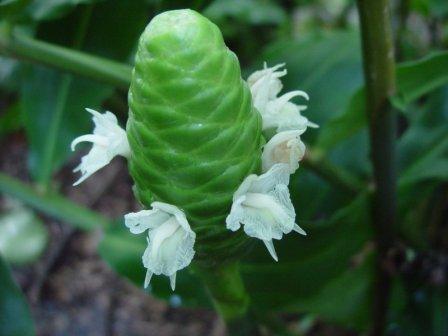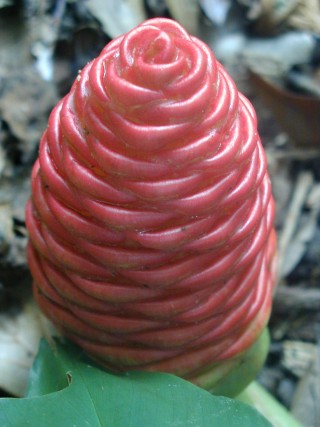

How to Grow and Take Care of Pinecone Red/Pink Gingers
Zingiber is native to eastern Asia, Indonesia, Malaysia and northern Australia. Plant clumps can be divided in spring by rhizome division. Stem cuttings can be laid horizontally on the ground and covered with 2 inches of leaf mulch. The cone inflorescence of Zingiber zerumbet is often used in cut flower arrangements after it has turned a deep rich red.
PLANT FAMILY: Zingiberaceae
BOTANICAL NAME: Zingiber zerumbet
TYPE PLANT: herb - Bracts inflorescence colour-Red / Pink.
Bracts shape-Acute tip
Height: 4-6 ft. (1.2-1.8 m)
Spacing: 12-15 in. (30-38 cm)
Sun Exposure: Full Sun to Partial Shade
Bloom Color: Pink, Rose/Mauve, Magenta (Pink-Purple), Red
Bloom Time: Blooms repeatedly
Foliage: Evergreen, Herbaceous
Other details: This plant is attractive to bees, butterflies and/or birds.
Requires consistently moist soil; do not let dry out between watering.
Flowers are good for cutting.
SOIL: Moisture-Moist, Well-drained Fertility-Rich, Moderately Rich pH-Neutral 6.1 to 6.5 (mildly acidic) to 6.6 to 7.5 (neutral).
COMMON NAMES: Awapuhi kuahiwi, pinecone ginger, Shampoo ginger.
SYNONYMS: Zingiber amaricans, Zingiber fairchild, Zingiber ovoideum.
Variety name-Red ginger lily / Pink ginger cone lily.
Pine cone ginger (Zingiber zerumbet), also known as shampoo ginger or awahupi, is named for the large pine cone-shaped flower of the plant. Once the plant has completed blooming the "pine cone" turns a deep reddish color and has a fragrant juice when squeezed, that some people use for shampoos. The pine cone ginger originates in eastern Asia and northern Australia. This plant grows the best in the tropical belts but with care it can do so in almost every climate. There are some basic things to care for your pine cone ginger plants.
Growing Instructions and Care
Find an area that gets equal parts sun and shade to keep your pine cone plant. Dig a hole around 5 to 6 inches around and a foot deep. Separate the roots before placing the pine cone plant in the hole. Fill back up with the dirt and pack around the plant tightly.
Water the pine cone ginger plant several times a day, the best times is in the morning, late afternoon and evening. Keep the ground moist, but not soaking wet.
Trim the plant back each year about an inch or two the first year and then add another inch after that. Once the plant starts to bloom, cut the bloom about 6 inches down on the stalk. After the plant is done blooming, trim the plant back to allow more blooms each year.
Fertilise the red pine cone ginger monthly throughout the growing season, using a plant food formulated for use on tropical, flowering plants.
Divide the underground rhizomes every three to five years to provide new starts for additional ginger plants. Dig up the roots late in the fall and divide them into sections of three to five rhizomes that each contains numerous leaf shoots. Plant them immediately in rich, loamy soil to encourage new growth in the springtime
Growing Red Pine Cone Ginger in pots
Choose a pot that is 2 to 3 inches larger than the pot holding your ginger plant. Both torch ginger and butterfly ginger grows in spreading rhizome root clumps.
Combine equal parts potting soil, perlite and peat moss to create a growing medium that provides support and good drainage. Fill the pot half full with the potting soil mix.
Remove the ginger plant from the nursery containers. Cut away plastic wrapping or thin plastic pouches. Remove a thicker pot or one you want to save by wiggling the container and squeezing it gently until it comes free from the root ball.
Rough up the outside surface of the ginger root ball with the palms of your hands.
Place the ginger plant into the new pot and hold it so that the soil line of the root ball is 1 inch lower than the top of the new container. Adjust the soil under the root ball to reach the correct depth in the new pot.
Add more of the soil mix around the roots to fill the pot to 1 inch below the top to allow space for water and fertilizer applications.
Water the Hawaiian ginger plant until the water seeps from the drainage hole in the bottom of the pot and then set the container in the sink to drain.
Place the Hawaiian ginger plant in an area that remains above 60 degrees Fahrenheit. A temperature range of 65 to 75 F is ideal. An area that receives filtered sunlight is best for this tropical plant.
Fill a saucer two-thirds full with pebbles. Use a saucer that is 1 to 2 inches larger than the base of the pot. Place the pot on the pebbles, and then add water to the saucer until it comes halfway up the layer of pebbles. As the water evaporates, it creates humidity around the plants.
Fertilise once a month with a liquid application of 10-10-10 balanced fertiliser. Follow the guidelines on the package to establish the right amount for each application.
Water when the top of the soil starts to feel dry and crumbly under your fingers. Soak the ginger plant until water drains through the pot, and then replace it on the pebbles.
Cut the flower stalks at the soil level when the ginger flowers fade. Remove dead foliage periodically at the soil line.
Usage
Pine cone ginger is a fast-growing plant that adds a tropical effect to landscapes. The stalks and cones are long-lasting and useful in cut flower arrangements. Zingiber zerumbet is also called "shampoo ginger" for the
milky substance in its cones, which is used as a natural shampoo in some tropical regions and is an ingredient in some commercial shampoo.



.
.